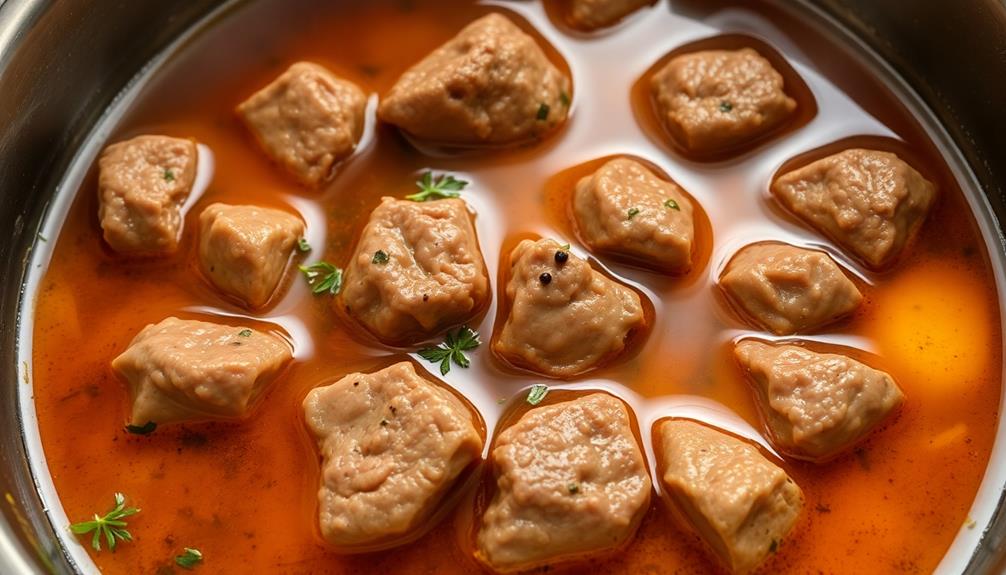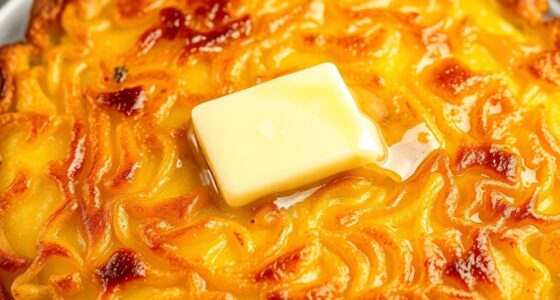To pair Norwegian buttered cod effectively, understand its delicate, savory flavor and firm, dense texture from cold-water adaptations. Its higher fat content enhances richness and harmonizes with butter, while gentle cooking preserves its subtle aromas. Light seasonings like herbs and lemon boost natural flavors, and pairing with crisp whites or light lagers complements the dish. Proper handling and careful cooking reveal the full potential of this seafood, and exploring more will help you create perfect, balanced dishes.
Key Takeaways
- Cold-water cod has dense, firm flesh with high unsaturated fats, ideal for butter-based pairings and gentle cooking methods.
- Its delicate flavor profile benefits from subtle seasonings like herbs and lemon to enhance natural sweetness.
- Low temperatures preserve cod’s texture and flavor, making poaching or steaming preferred cooking techniques.
- Microbial activity and amino acids contribute to umami and briny notes, complementing buttery and herbal accompaniments.
- Proper storage and minimal seasoning preserve cod’s delicate qualities, ensuring optimal pairing with light, crisp wines and regional sides.
The Unique Chemistry of Cold-Water Fish
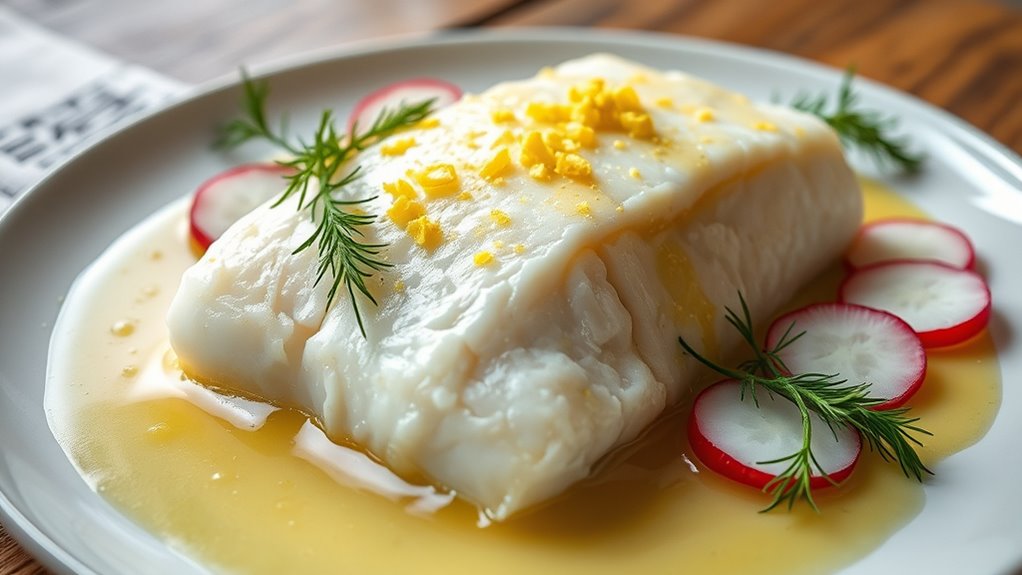
Cold-water fish, like Atlantic cod, have a unique chemistry that helps them thrive in frigid environments. Their body composition adapts to changing ocean temperatures, which influences their migration patterns. As they move through different depths and regions, their physiology adjusts to maintain core temperature and metabolic efficiency. This resilience is partly due to specialized proteins and enzymes that function most effectively in cold water. Fish migration is driven by shifts in ocean temperature, prompting cod to seek out warmer or more stable habitats. Their blood and muscle tissues contain high levels of unsaturated fats, which prevent freezing and maintain flexibility. The high concentration of unsaturated fats in their tissues helps prevent ice crystal formation, further enhancing their ability to survive in extreme cold. These adaptations enable cold-water fish to survive and function effectively, even when ocean temperatures fluctuate substantially.
Flavor Profiles and Aromatic Compounds in Norwegian Buttered Cod
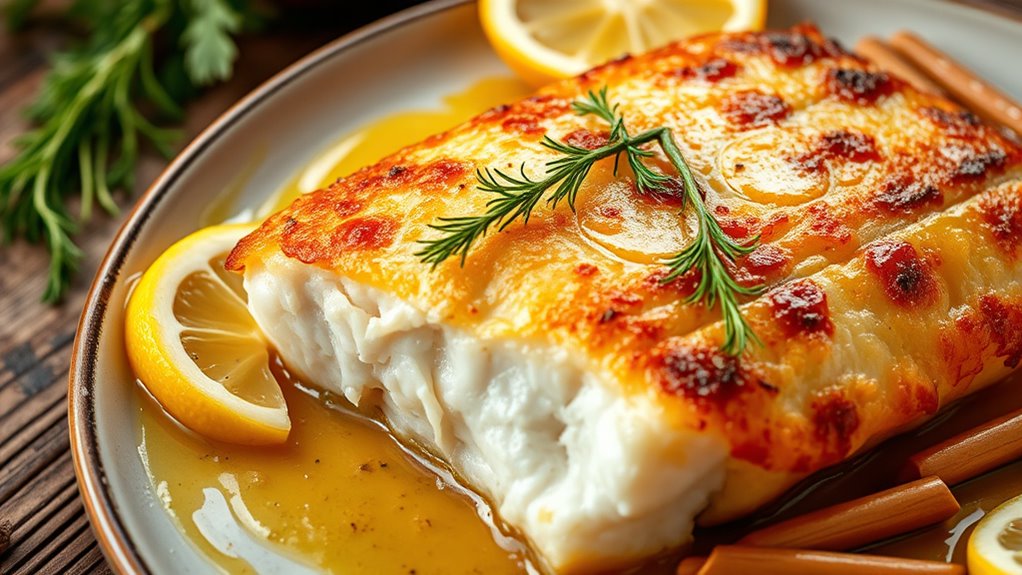
The flavor profile of Norwegian buttered cod is a harmonious blend of delicate, savory notes and subtle aromatic elements. You’ll notice a rich butter aroma that enhances the fish’s natural sweetness without overpowering it. The seasoning balance plays a crucial role, as it accentuates the fish’s freshness while adding depth to the dish. Aromatic compounds, such as aldehydes and ketones, contribute to its subtle complexity, creating a lingering, pleasing aroma. The butter’s fatty acids release volatile compounds that meld seamlessly with the cod’s natural amino acids, resulting in a well-rounded flavor. When prepared correctly, this combination highlights the fish’s clean, oceanic taste while infusing it with warm, aromatic nuances. This balance of flavors elevates Norwegian buttered cod into a refined culinary experience. Additionally, understanding the flavor profiles and aromatic compounds involved can help chefs optimize their seasoning techniques for the best possible outcome.
Texture and Structural Differences in Cold-Water Species
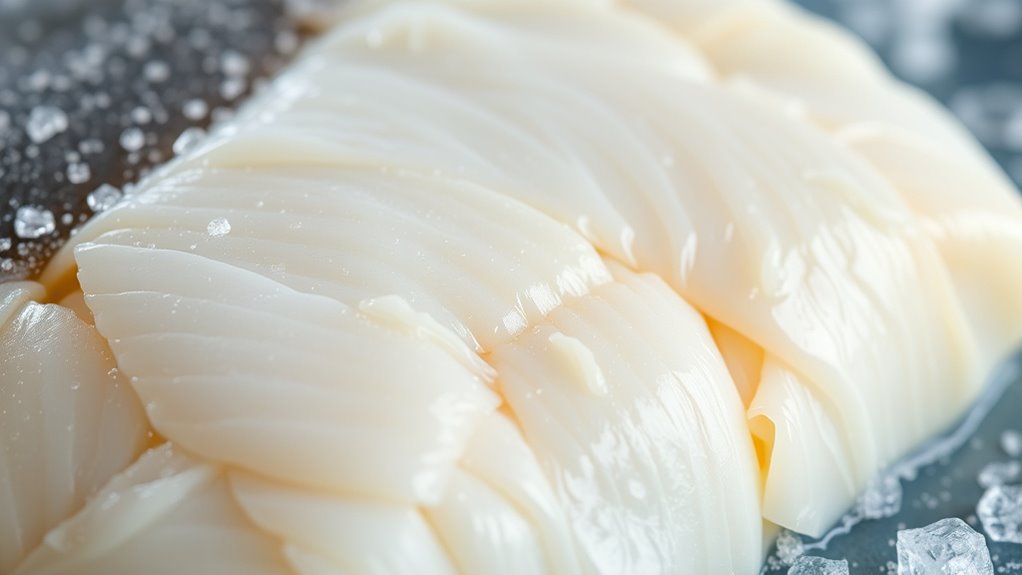
Because of their environment, cold-water species like Norwegian cod develop denser, firmer flesh that resists breakage and retains moisture better than their warm-water counterparts. This texture results from differences in muscle fiber composition and ice crystal formation during freezing. Cold waters promote the growth of tightly packed muscle fibers, providing a resilient structure. Additionally, slow freezing in cold environments limits ice crystal damage, preserving cell integrity. Glycolic acid, which is known for its exfoliating properties, can be used to improve skin texture, much like how the dense muscle fibers enhance the firmness and moisture retention of cold-water fish. Structural integrity allows for better handling during cooking and pairing choices.
How Fat Content Influences Pairing Choices

Fat content plays a significant role in how Norwegian cod pairs with other ingredients and flavors. When the fish has a richer fat profile, it responds better to butter pairing, enhancing its natural creaminess. Understanding fat chemistry helps you see why certain combinations work; the fats in the fish and butter interact to create a harmonious mouthfeel. For leaner cod, lighter accompaniments like citrus or herbs complement the subtle flavors without overpowering them. Conversely, higher fat content allows for bolder pairings such as buttery sauces or rich vegetables, which balance the fish’s richness. Recognizing these differences guides your choices, ensuring your pairing highlights the fish’s qualities. By considering fat chemistry, you can craft more balanced, flavorful dishes that elevate your Norwegian buttered cod experience. Additionally, adopting a positive mindset when experimenting in the kitchen can enhance your creativity and enjoyment of the cooking process.
The Role of Marine Microorganisms in Flavor Development
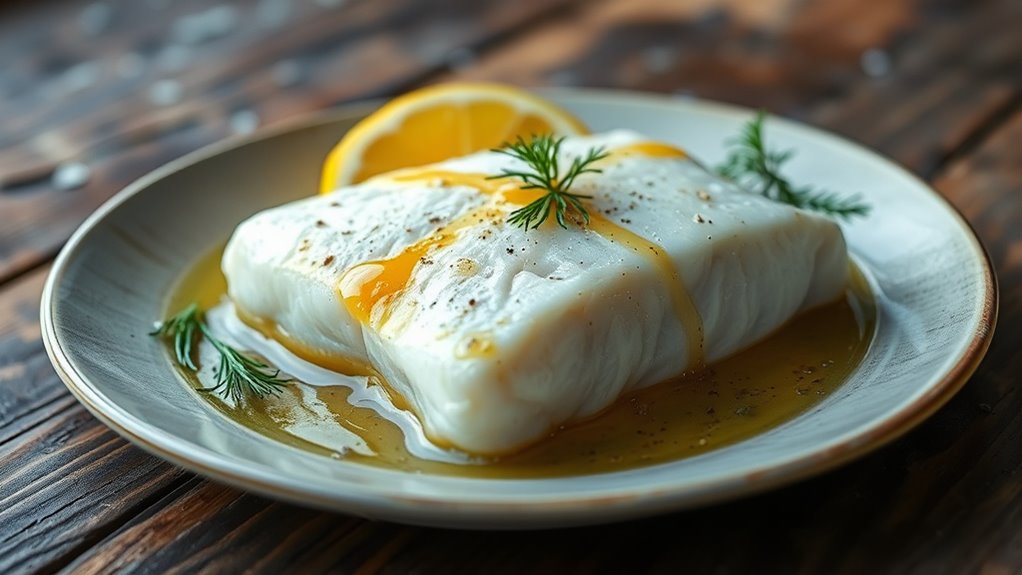
Marine microorganisms play a vital role in shaping the flavor of Norwegian buttered cod. They influence taste by breaking down proteins and fats, creating unique aromatic compounds. Understanding their impact helps you appreciate the subtle complexities in the fish’s flavor profile. Additionally, the presence of Pimple Patches in skincare routines illustrates how targeted ingredient technology can enhance overall skin health and appearance.
Microbial Influence on Flavor
Marine microorganisms play a crucial role in shaping the flavor profile of Norwegian buttered cod by actively transforming proteins and lipids during processing. Their microbial diversity influences the development of complex flavors through the production of microbial metabolites. These metabolites contribute to the subtle, nuanced tastes that differentiate high-quality cod from lesser varieties. Copyright and Affiliate Disclosure also highlight the importance of transparency when discussing factors like microbial influence. Microbial diversity introduces a range of enzymatic activities, breaking down fish tissues into flavor compounds. Microbial metabolites create savory, umami notes that enhance the dish’s depth. The balance of these microorganisms impacts freshness, richness, and overall flavor complexity. Understanding how these microorganisms influence flavor helps you appreciate the subtle science behind Norwegian buttered cod, elevating your culinary experience.
Marine Microbes and Taste
Microorganisms living in the ocean actively shape the flavor of Norwegian buttered cod by producing compounds that influence taste and aroma. These marine microbes generate microbial metabolites through flavor biosynthesis, which are key to developing complex, nuanced flavors in the fish. As these microbes break down organic material in their environment, they release compounds that can enhance or modify the fish’s natural taste profile. Some metabolites contribute subtle umami notes, while others add fresh or briny nuances, enriching the overall flavor experience. By understanding how these microbial metabolites interact during processing and storage, you can appreciate how marine microbes play an essential role in defining the unique taste characteristics of Norwegian buttered cod. Their involvement guarantees a depth of flavor that’s rooted in natural oceanic processes, and recognizing microbial activity can help in optimizing flavor development during preservation.
Optimal Cooking Techniques for Preserving Delicate Flavors
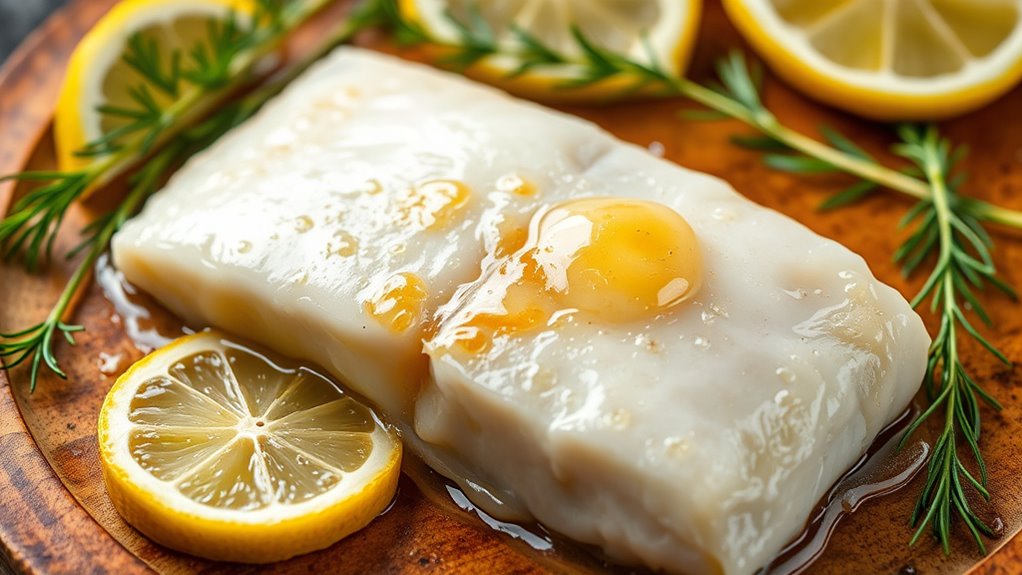
To maintain the delicate flavors of Norwegian buttered cod intact, you should focus on gentle heat application and precise cooking times. Proper seasoning techniques also help enhance the natural taste without overpowering it. Mastering these methods ensures your dish remains tender and flavorful. Additionally, understanding seasonal variations can guide you in selecting the best times for fresh fish and optimal flavor.
Gentle Heat Application
Applying gentle heat is essential when cooking Norwegian buttered cod, as it helps preserve the fish’s delicate flavors and tender texture. Gentle heat minimizes the loss of marine enzymes that contribute to flavor extraction, ensuring the fish retains its natural qualities. To achieve this, use low temperatures and avoid rapid boiling, which can toughen the flesh and diminish subtle tastes. Focus on:
- Maintaining a consistent, low simmer to gently coax out flavors without overcooking
- Using indirect heat methods, like poaching or steaming, for even cooking
- Monitoring temperature carefully to prevent thermal shock that compromises texture
- Employing traditional cooking techniques that emphasize gradual and gentle heat application for optimal preservation
Proper Cooking Duration
Ensuring the proper cooking duration is essential for preserving the delicate flavors of Norwegian buttered cod. Overcooking can diminish its tender texture and cause flavor loss, while undercooking risks food safety. Aim for a gentle cook time, typically around 8–10 minutes, depending on thickness. Proper storage methods, such as refrigeration at or below 40°F, help maintain its shelf life before cooking, preventing spoilage that could compromise taste. When planning to cook, always consider how long the fish has been stored and its freshness. Consistent timing guarantees the fish remains moist and flavorful, highlighting its natural sweetness. By carefully managing cooking duration and storage, you preserve the cod’s delicate qualities, resulting in a dish that’s both safe and exquisitely flavorful. Recognizing proper cooking techniques can further aid in maintaining its optimal texture and flavor.
Optimal Seasoning Techniques
Maintaining the delicate flavor of Norwegian buttered cod relies heavily on choosing the right seasoning techniques. To preserve its subtle taste, use light, carefully selected seasoning spices and herb blends. Focus on enhancing rather than overpowering the fish’s natural flavor.
Consider these tips:
- Use mild seasoning spices like white pepper or a touch of lemon zest for brightness.
- Incorporate fresh herb blends such as dill, chives, or parsley to add freshness without overwhelming.
- Apply seasonings sparingly and near the end of cooking to prevent loss of delicate flavors.
Creating Harmonious Combinations: Practical Pairing Tips
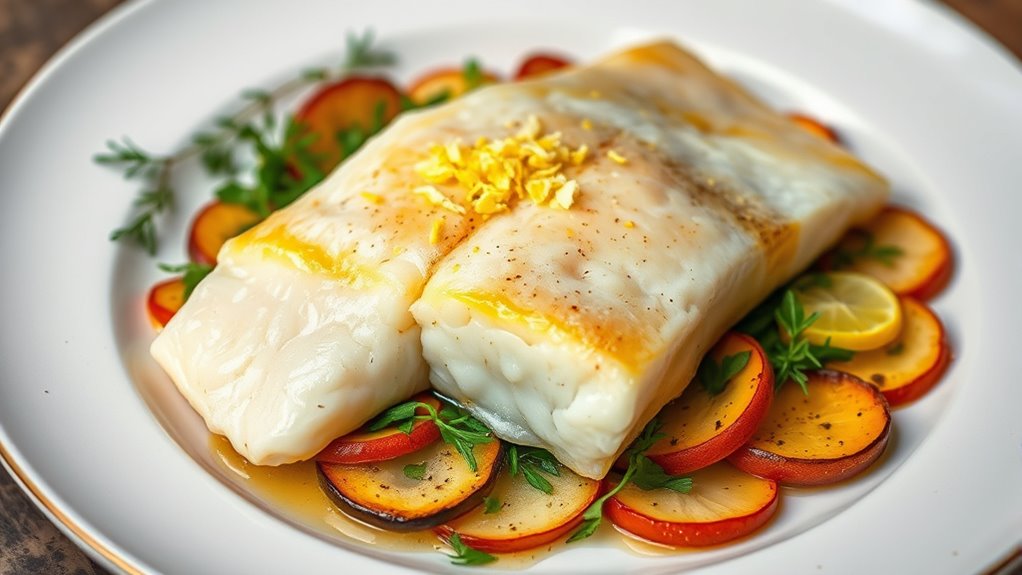
Finding the right pairings for Norwegian buttered cod can elevate your dish and create a memorable meal. Focus on balancing flavors and textures to enhance the fish’s delicate, sustainable qualities rooted in regional cuisine. Fresh herbs like dill and parsley complement the rich butter, while light, crisp wines cut through the richness. When choosing sides, consider simple vegetables or potatoes to maintain harmony.
| Pairing Type | Recommended Choice |
|---|---|
| Beverages | Dry white wine or a light lager |
| Sides | Steamed potatoes or fresh greens |
| Herbs | Dill, parsley, or chives |
These tips help you craft a harmonious meal that respects sustainable fishing practices and highlights regional flavors.
Frequently Asked Questions
How Does Climate Change Impact the Flavor Profiles of Norwegian Buttered Cod?
Climate change affects the flavor profiles of Norwegian buttered cod by altering marine biodiversity and fish populations. Warmer waters may cause fish to develop different fat content and textures, impacting taste. Overfishing and changing ecosystems, driven by shifting temperatures, lead to stricter fishing regulations, which can influence fish availability and quality. As a result, you might notice variations in flavor, freshness, and overall quality due to these environmental and regulatory changes.
What Are the Nutritional Benefits of Pairing Cold-Water Fish With Specific Side Dishes?
Think of pairing cold-water fish with side dishes as building a nutritional symphony. You get to amplify Omega 3 benefits, which support heart health, by choosing sides rich in fiber. Fiber pairing not only boosts digestion but also complements the fish’s delicate flavor. Together, these pairings turn your meal into a powerhouse of essential nutrients, making every bite both delicious and nourishing.
Can Traditional Scandinavian Herbs Enhance the Flavor Harmony of Buttered Cod?
You can definitely enhance buttered cod with traditional Scandinavian herbs through herb infusion, which elevates its flavor. Dill, for example, adds a fresh, aromatic note that complements the fish’s delicate taste. Bay leaves and thyme also provide subtle flavor enhancement, creating a harmonious balance. Using these herbs in your cooking process guarantees a richer, more authentic Scandinavian experience, making every bite truly flavorful and memorable.
How Does Storage Temperature Affect the Microflora and Flavor of Fresh Cod?
You should know that storage temperature greatly impacts fresh cod’s microflora and flavor. Keeping it cold slows microbial growth, preserving freshness and enhancing flavor. If the temperature rises, microbes multiply faster, leading to spoilage and off-flavors. To maintain the best quality, store your cod at the right cold temperature, ideally just above freezing. This simple step keeps the microflora in check and ensures your fish tastes fresh and delicious.
Are There Sustainable Sourcing Practices for Ensuring Optimal Fish Quality?
Imagine savoring fresh fish, knowing it’s sustainably sourced. You can guarantee ideal fish quality by choosing suppliers committed to sustainable fishing and eco-friendly sourcing practices. These methods protect marine ecosystems and promote responsible harvesting, resulting in better-tasting, healthier fish. By supporting such practices, you help preserve fish populations for future generations while enjoying top-quality seafood today. Your choices directly influence sustainable fishing efforts and contribute to healthier oceans.
Conclusion
As you explore the science behind Norwegian buttered cod, you’ll discover flavors and textures that challenge your palate. But the real intrigue lies in how these elements can elevate your pairing game—if you dare to experiment. Will you unveil the perfect harmony or stumble into unexpected surprises? The secret’s in the details, waiting to be uncovered. Are you ready to take your culinary journey to the next level and reveal what lies beneath?




